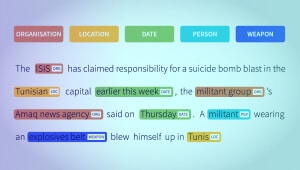What is Text Annotation in Machine Learning?
Text annotation in machine learning refers to adding metadata or labels to raw textual data to create structured datasets for training, evaluating, and improving machine learning models. It is a crucial step in natural language processing (NLP) tasks, as it helps algorithms understand, interpret, and make predictions based on textual inputs.
Text annotation is important because it helps bridge the gap between unstructured textual data and structured, machine-readable data. This enables machine learning models to learn and generalize patterns from the annotated examples.
High-quality annotations are vital for building accurate and robust models. This is why careful attention to detail, consistency, and domain expertise is essential in text annotation.
Types of Text Annotation

When training NLP algorithms, it’s essential to have large annotated text datasets tailored to each project’s unique needs. So, for developers who want to create such datasets, here’s a simple overview of five popular text annotation types.

Sentiment Annotation
Sentiment annotation identifies a text’s underlying emotions, opinions, or attitudes. Annotators label textual segments with positive, negative, or neutral sentiment tags. Sentiment analysis, a key application of this annotation type, is widely used in social media monitoring, customer feedback analysis, and market research.
Machine learning models can automatically evaluate and classify opinions in product reviews, tweets, or other user-generated content when trained on annotated sentiment datasets. Thus, it enables AI systems to analyze sentiment effectively.

Intent Annotation
Intent annotation aims to capture the purpose or goal behind a given text. In this type of annotation, annotators assign labels to text segments representing specific user intentions, such as asking for information, requesting something, or expressing a preference.
Intent annotation is particularly valuable in developing AI-powered chatbots and virtual assistants. These conversational agents can train models on intent-annotated datasets to better understand user inputs, provide appropriate responses, or perform the desired actions.

Semantic Annotation
Semantic annotation identifies the meaning and relationships between words, phrases, and sentences. Annotators use various techniques, such as text segmentation, document analysis, and text extraction, to label and classify the semantic properties of text elements.
Applications of semantic annotation include:
- Semantic analysis: Examining and interpreting the meaning of words and phrases within context, enabling better text understanding.
- Knowledge graph construction: Building interconnected networks of entities and their relationships, which help organize and visualize complex information.
- Information retrieval: Finding and extracting relevant data from large collections of texts makes accessing specific information easier.
Using machine learning models trained on data with semantic annotations, AI systems can better understand and process complex text, which helps improve their language comprehension abilities.

Entity Annotation
Entity annotation is crucial in creating chatbot training datasets and other NLP data. It involves finding and labeling entities in text. Types of entity annotation include:
- Named entity recognition (NER): Labeling entities with specific names.
- Keyphrase tagging: Identifying and marking keywords or keyphrases in text.
- Part-of-speech (POS) tagging: Recognizing and labeling different speech elements, like adjectives, nouns, and verbs.
Entity annotation assists NLP models in identifying parts of speech, recognizing named entities, and detecting keyphrases within the text. Annotators carefully read the text, find target entities, highlight them on the platform, and choose from a list of labels. To further assist NLP models in understanding named entities, entity annotation is often combined with entity linking.

Linguistic Annotation
Linguistic annotation deals with the structural and grammatical aspects of language. It encompasses various sub-tasks, such as part-of-speech tagging, syntactic parsing, and morphological analysis.
Annotators label textual elements according to their grammatical roles, syntactic structures, or morphological features, providing a comprehensive linguistic representation of the text.
When AI systems are trained on datasets with linguistic annotations, they can better understand language patterns and produce clearer, more accurate results.
Use cases of Text Annotation
Text annotation plays a significant role in various industries by transforming unstructured textual data into structured, machine-readable formats for AI and machine-learning applications. Here are some notable use cases of text annotation.

Insurance
Text annotation helps insurance companies analyze customer feedback, process claims, and detect fraud. By using AI models trained on annotated datasets, insurers can:
- Better understanding and classifying policyholder inquiries
- Automatically process claim documents
- Identify patterns indicative of fraudulent activities

Banking
Text annotation facilitates improved customer service, fraud detection, and document analysis in banking. AI systems trained on annotated data can:
- Automatically classify customer requests
- Analyze sentiments in user reviews
- Process loan applications
These models can also identify fraudulent transactions or suspicious patterns within textual data.

Telecom
Text annotation enables telecom companies to enhance customer support, monitor social media, and manage network issues. Machine learning models trained on annotated datasets can:
- Identify customer complaints
- Understand user sentiments
- Prioritize network maintenance tasks based on the severity of reported issues
How To Annotate Text Data?

- Define the annotation task: Determine the specific NLP task you want to address, such as sentiment analysis, named entity recognition, or text classification.
- Choose a suitable annotation tool: Select a text annotation tool or platform that meets your project requirements and supports the desired annotation types.
- Create annotation guidelines: Develop clear and consistent guidelines for annotators to follow, ensuring high-quality and accurate annotations.
- Select and prepare the data: Gather a diverse and representative sample of raw text data for the annotators to work on.
- Train and evaluate annotators: Provide training and continuous feedback to annotators, ensuring consistency and quality in the annotation process.
- Annotate the data: Annotators label the text according to the defined guidelines and annotation types.
- Review and refine annotations: Regularly review and refine the annotations, addressing any inconsistencies or errors and iteratively improving the dataset.
- Split the dataset: Divide the annotated data into training, validation, and testing sets to train and evaluate the machine learning model.
What Can Shaip Do For You?
Shaip offers tailored text annotation solutions to power your AI and machine learning applications in various industries. With a strong focus on high-quality and accurate annotations, Shaip’s experienced team and advanced annotation platform can handle diverse text data.
Whether it’s sentiment analysis, named entity recognition, or text classification, Shaip delivers custom datasets to help enhance your AI models’ language understanding and performance.
Trust Shaip to streamline your text annotation process and ensure your AI systems reach their full potential.


